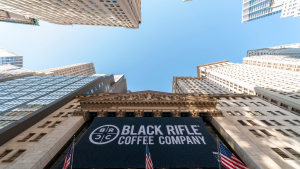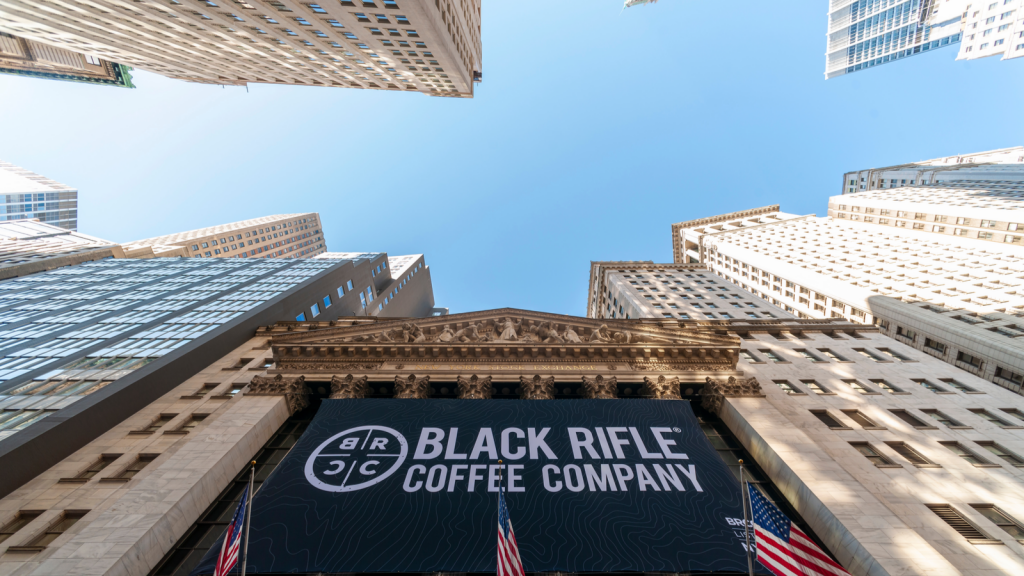BRC Inc. (NYSE:BRCC), which does business as the Black Rifle Coffee Company, recently closed its reverse merger and went public on Feb. 10. BRCC stock shot up from the $10 to $11 range it had been trading at. As of Friday, Mar. 4, it is at $18.60. This puts its valuation in nosebleed territory.

For example, based on page 51 of the company’s own slide presentation, there are now 191.4 million common stock shares outstanding at the close. So if we multiply $18.60 by 191.4 million, we get a market capitalization of $3.56 billion.
That simply appears untethered to any notion or concept of value. Let’s look into this further.
Where Things Stand at Black Rifle Coffee
The only real fact that we have so far is that BRC Inc. made just $161.2 million in total sales for the nine months ending Sep. 30, 2021. This is taken from the company’s consolidated financial statements filed with the U.S. Securities and Exchange Commission.
However, page 39 of the company’s slide deck indicates that the company will make $230 million in sales by the end of 2021. That implies two things.
First, it assumes the company had a blowout fourth quarter (up 42.7% from $161.2 million to $230 million in just three months). That is a little difficult to believe, but I suppose it is possible. We won’t know for sure until the company announces its 2021 results.
Second, it puts BRCC stock on a historical price-to-sales (P/S) multiple of 15.5 times (i.e., $3.56 billion/$230 million). That is simply excessive. But, of course, markets look forward. Let’s see where BRC says sales will be in the future.
Valuation Issues with BRCC Stock
Page 55 of the slide deck predicts that sales will hit $311.4 million in 2022 and $430.4 million in 2023. That lowers the P/S multiple to 11.4 times for 2022 and 8.3 for 2023.
The problem is these are ratios that are typical of a price-to-earnings (P/E) multiple, not a P/S ratio. And that is the case as BRC is not net income profitable. As of Sep. 30, 2021, it had a $9.2 million net income loss. The company claims it will be profitable on an earnings before interest, taxes, depreciation, and amortization (EBITDA) basis in 2021 in the amount of $0.6 million.
But that is after adjustments that it makes. The problem is that EBITDA profits cannot be spent as cash can be spent. But, again, let’s play along with the company’s projections.
In 2022, it projects the same $0.6 adjusted EBITDA, and it is only by 2023 that there will be real EBITDA profits forecast ($15.1). However, this still puts the stock on a Price/EBITDA multiple of 235 times for 2023.
That seems excessively high, especially since there are so many growth assumptions built into the forecast.
Another issue is that there are a number of founders warrants and management warrants that are likely now in the money. That raises the prospect that there are probably now more than 200 million shares outstanding on a real diluted basis. So, the actual real market cap is north of $3.72 billion. That raises the valuation issues mentioned above even higher.
What Happened to the Series A Preferred Stock?
I looked carefully at the use of funds from the closing of the special purpose acquisition company (SPAC) merger. The original company, Authentic Brands, had both common stock shareholders — which folded their equity into BRCC stock — but also Series A preferred stock.
The preferred stock refused to roll their investment over into common stock — not that they were required to do so. As a result, they received a payout of roughly about half of the $300 million in cash that was raised in the reverse merger deal. I find this very strange.
Most initial public offerings (IPOs) have long-term investors who also have preferred stock in the company, but they typically will rollover their preferred stock to common stock. Authentic Brands wanted to get rid of these preferred stock owners since it was costing them 7.5% in annual interest on about $140 to $150 million, or roughly $10 to $11 million annually. So, from that standpoint, I can see why this was done. But investors should be aware that this situation is a lot different than a typical IPO.
Where This Leaves BRCC Stock
It makes no sense to buy an overvalued stock hoping that growth projections will come true and eventually push the stock even higher. That is the situation here with BRCC stock. This is also known as “greater fool theory” investing. Buyers essentially hope to sell their shares to greater fools than themselves.
But present investors might also have some cause for concern. Once the existing warrant holders are allowed to convert and sell, they will likely do so. That could act as a negative catalyst on the stock.
Simply put, BRCC stock is overvalued. Most value investors will shy away from this as a potential investment.
On the date of publication, Mark Hake did not hold (either directly or indirectly) any positions in the securities mentioned in this article. The opinions expressed in this article are those of the writer, subject to the InvestorPlace.com Publishing Guidelines.
